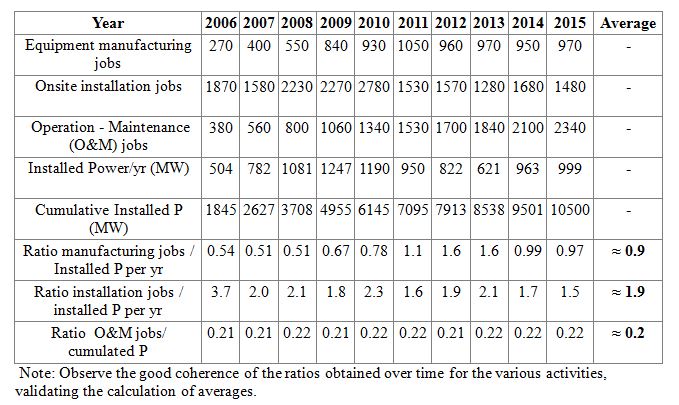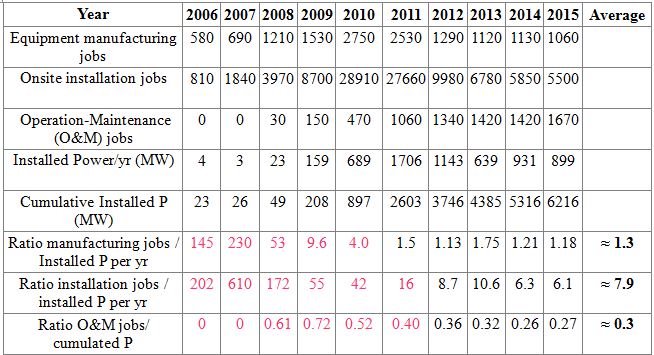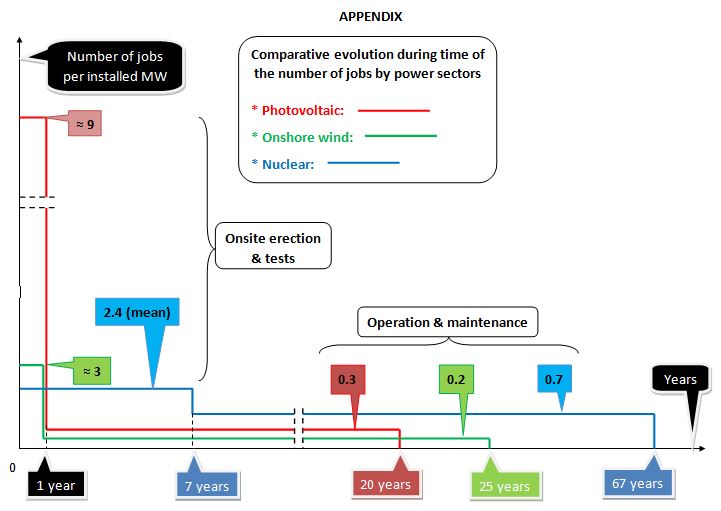"Green" jobs: the end of false hopes
"Green" jobs created in solar Photovoltaic and wind power deployment compared to nuclear power jobs: the end of false hopes... At least, in France!
The claim that renewable energies, in particular wind and solar PV, generate massive employment opportunities has often been put forward. This, however, is untrue, as we show below in an analysis of employment data in the French context.
Summary and Conclusions:
The claim that renewable energies, in particular wind and solar PV, generate massive employment opportunities has often been put forward. For example, Ms Sabine BUIS, representative to the French Assemblée Nationale declared, on October 14, 2013: "We know, for example, that for each solar PV Megawatt (MW), 9 jobs are created which are, for the most part, necessarily local. Each MW of wind power corresponds to 3.3 new jobs, while for nuclear there is only 1 job per MW."
This claim is utterly false, as we show in this note with an analysis of the number of jobs really created. Numbers close to those cited above (9.2 jobs/MW for solar PV and 2.8 jobs/MW for wind) are, indeed, observed. But the duration of these jobs is only ONE year, the FIRST year, that of the construction of the installations. These jobs are thus short-lived. Starting from the second year, they drop to only 0.3 and 0.2 jobs respectively over the 20 to 25 years of operation (see also the illustration in the APPENDIX).
This is due for a large part to the fact that these devices are not manufactured nationally: the land wind turbine nacelles and their blades (three fourths of the total cost of an installation) are imported. The same is true of the PV panels (half of the total cost of an installation). These sectors, then, do not create high value added industrial employment and, additionally, they weigh upon our imports.
In comparison, nuclear power engages, on average, 2.4 jobs/MW during the 7 years of plant construction, and 0.7 jobs during the 40 to 60 exploitation years. Moreover, this sector generates a majority of high value added national industrial jobs. It contributes to French exports, with the sale abroad of electricity as well as of many nuclear goods and services (engineering, components, maintenance, fuel processing, etc.)
The conclusion is thus without dispute and contrary to preconceptions:
Solar PV and wind power create much less employment than nuclear power, and this employment is much less productive in terms of energy.
Any hope to reduce unemployment by deploying wind turbines and solar PV thus belongs to... wishful thinking, not to fact!
- Analysis Methods
We aim at determining the ratios of direct + indirect employment in equivalent full time occupation, per:
- MW built and brought into operation within the year for the jobs concerning equipment manufacturing and onsite installation, considering the short time frame of these activities for wind turbines and even more so for solar PV (<< year)
- Cumulative MW for exploitation and maintenance jobs, these obviously bearing on the total installed fleet from the beginning.
- Data (Ref [2]) for Wind Power Results
Assessment Summary: the following synthesis can be derived from these figures:
- Manufacturing/Installation phase jobs: 0.9+1.9=2.8 jobs/MW installed in one year
- Exploitation/maintenance phase jobs: 0.2/MW during operation (cumulated installed power)
- Data (Ref [2]) for Solar PV Results
Note: Contrary to the wind data, the solar PV data of the first years present many aberrant values, probably because of difficulties and lack of precision in the data collection concerning employment in the early years of this activity. They are marked in red in the tables and do not contribute to the calculation of the averages. Only the figures of the later years, which are much more coherent, homogeneous and stable, are used in our calculations of averages.
Assessment Summary: the following synthesis can be derived from these figures:
- Manufacturing/Installation phase jobs: 1.3+7.9=9.2 jobs/MW installed in one year.
- Exploitation/maintenance phase jobs: 0.3/MW during operation (cumulated installed power)
- Data (Ref [1] and [3] Nuclear Power Results
We deduce the ratios given below from Ref [3] and the work force effectively employed in the construction sites (EPR) and the existing sites now in operation.
Now, considering the entire nuclear power sector, including R&D, the French industrial base involved in fabrication and maintenance as well as export (engineering, services and maintenance for foreign operators, nuclear fuel supply, fuel processing, etc.) the number of jobs adds up to 220 000 (Ref [1]) for a production fleet representing 63.2 GW plus the 1.7 GW of the EPR being built, i.e. a rounded total of 65 GW. This yields a ratio 220 000/65 000 ≈ 3.4 jobs/cumulated installed MW.
By comparison, the global figures for the year 2015 (Tables of §2 and §3 above) yield 0.46 jobs/cumulated installed MW for wind power and 1.3 jobs/cumulated installed MW for solar PV.
- Wind Power and Solar PV Jobs Compared to Nuclear Power Jobs
Whatever the comparison angle chosen, the claim that wind and solar PV power create more jobs than nuclear power is counter-factual: in fact, the exact opposite is observed on the basis of undebatable data.
We do, indeed, find figures that are very close to those quoted by Sabine BUIS, i.e. 9 jobs/MW for solar PV (9.2 here) and 3.3 jobs/MW for wind (2.8 here). Except that, and it is of course essential, these figures apply to only ONE year, the FIRST one. There is an explanation for this: the installation construction work is of very short duration, much less than a year, so that the activity fits within a year. From the second year on, the jobs fall to only 0.3 and 0.2 respectively (see also the diagram in the Appendix).
These two sectors, then, generate short term jobs during the construction/installation phase, with very negative effects: as soon as investments are interrupted during just one year, the jobs involved simply disappear altogether. Employment is kept stable only if the sums invested from year to year are constant, in a characteristic headlong move. It is indeed what has been observed, as Daniel Bour, president of the Générale du Solaire Group admits, as quoted in Ref [1]: "It is generally admitted that the sector has lost nearly 60 % of its work force between 2011 and 2013, declining from 25 000 to 10 000 jobs within less than two years".
Note that, in addition, with the recent but growing development of ground solar PV installations, including industrial ones, the average number of jobs in the solar PV sector for onsite construction should logically be reduced; ground solar PV installations require much less labor than roof solar PV installations do.
- Comparative per Job Energy Production for Wind, Solar PV and Nuclear Power.
The matter can be considered from another perspective, the amount of energy produced per job, during the operation & maintenance phase for each of the sources. This represents an estimation of the productivity of these jobs. The mean load factor of these sources has to be taken into account. These are in France 13% for solar PV, 22% for land wind power (taking the observed average for the entire metropolitan territory for these two sectors) and 80% for nuclear power. The results are summarized in the table below.
As this table shows, nuclear power is the sector that produces the largest number of MWh per year per job. This is because it can be operated at full power much longer than the other sources, with 7000 hours/year equivalent full power for nuclear, 1930 hours/year for wind and only 1140 hours/year for solar PV. Moreover, nuclear power produces on demand, imparting a much larger economic value to its MWh on the electricity grid. Wind power is not far behind considering the MWh produced per job per year but its production does not have near the same value: it is intermittent and needs backup (controllable production devices, storage devices, etc.). Solar PV is far behind and it, too, requires backup power.
Summing up the discussion above, not only does nuclear power create more jobs per installed MW but also, each of these jobs produces more electricity than wind or solar PV and the electricity produced has a much larger added value for the grid.
- Comparative Impacts on the Trade Balance.
From the trade balance perspective, the performances of these industries are totally opposite. Indeed:
- The nuclear industry is a strong exporter with the sale of nuclear electricity for 2.5 billion € per year in normal years, from which about 0.5 billion € should be deducted for uranium ore imports; moreover, the industry exports nuclear goods and services as mentioned above in §4.
- On the contrary, the wind power and solar PV sectors are strong importers: all the nacelles and blades of land wind turbines are imported at a cost that represents more than three fourths of the total investment; all the solar PV panels are imported, at a cost that represents about half the total investment. It is not clear how this situation could be changed in the short or medium term, there being no active French industry in these sectors. Based on the investments engaged in these two sectors in 2015 (Tables in §2 and §3) and on the share of the imported components just mentioned, the component import outlay can be estimated at 2.5 billion €... thus more or less annihilating the benefit gained from the nuclear industry exports.
References
Ref [1]: Employment Les énergies renouvelables ne sont pas l'eldorado annoncé (Renewable energies are not the El Dorado announced) by Frédéric de Monicault - Le Figaro 2017/02/27.
Ref [2]: MARCHES ET EMPLOIS LIES A L’EFFICACITE ENERGETIQUE ET AUX ENERGIES RENOUVELABLES : SITUATION 2013-2014 ET PERSPECTIVES A COURT TERME (Markets and employment related to energy efficiency and renewable energies: situation in 2013-2014 and short term perspectives) ADEME - April 2016
Ref [3]: Le poids socio-économique de l’électronucléaire en France (The socio-economic incidence of nuclear power in France) PWC - May 2011
* Factual data relative to the work force engaged on the nuclear power sites in construction and in operation (weighted according to the number of reactors per site and their size). Non confidential information, EDF source.
APPENDIX
Comparative temporal evolution of the average number of jobs for each of the primary sources considered.









